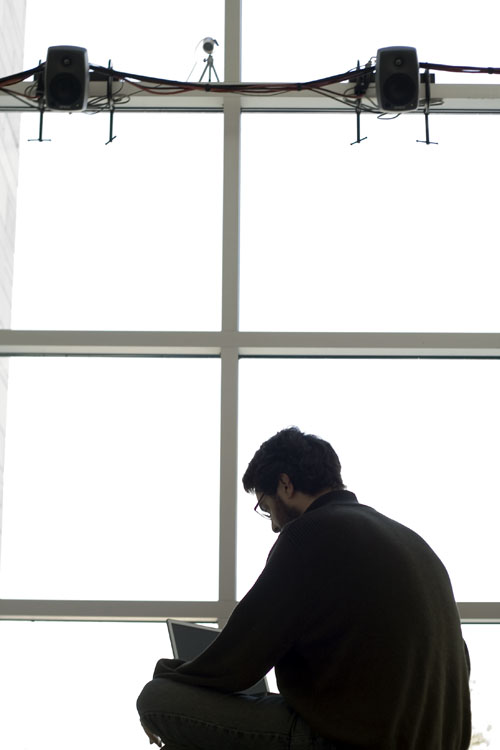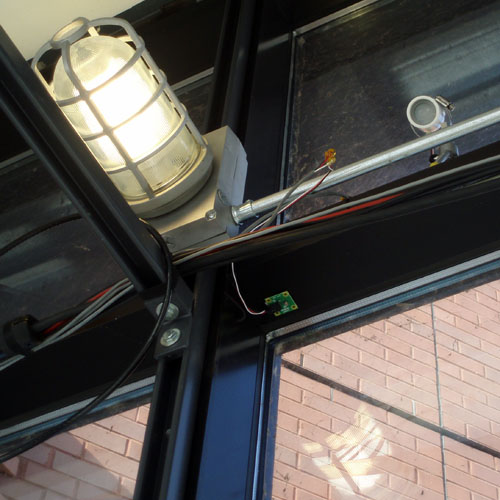Sound Garden
Sound Garden is a musical installation that explores the relationship of people, location, and audio relative to technology, and extends the concepts of Perturb through telematic collaboration and environmental sensors. Sound Garden provides an online interface that complements the physical activities of organic gardening by allowing listeners to tend a continuous sonic environment and take an active role in its composition and care. Using a web-based interface anyone can contribute their own digital audio files that grow to form the overall sonic landscape of Sound Garden.
Because each sound is unique, the "seeds" that are planted will significantly affect the primary characteristics of the garden. A generative musical system uses Particle Swarm Optimization (Kennedy & Eberhart 1995) to grow these seeds and define the overall structure. But Sound Garden is also largely shaped by events that occur at the site of installation. Environmental sensors tracking ambient light levels, temperature, motion, and vibration act on individual sounds that compose the garden. These sensors serve as additional layers in the musical system, and control a variety of signal processing parameters. As environmental conditions shift and change, the sensors reflect that change in the garden's constant growth and development.
System sounds served as the general tone of Sound Garden, and was meant to act as a sort of aural primer or sonic invitation to encourage interaction. These, plus sounds "planted" (uploaded via web interface) by participants in the work were internally routed from the generative system via Soundflower to an audio processing patch developed in Max/MSP. This Max/MSP patch also served as the hub for incoming sensor data. All environmental data could be used to immediately act on the sounds coming from the swarm and produce the music of Sound Garden.
Sound Garden advanced the musical concerns of Perturb because it expanded the potential for interaction by moving the interface to "plant" and "prune" sounds to the Internet. The subtitle of the piece is "asynchronous improvisation by Norbert Herber + others." Unlike Perturb, interaction was telematic. The asynchrony created through an online interface introduced subtle changes to the coupled relationships of interaction, and fit in well with the gardening metaphor. Organic plants grow slowly and so did this music due to the arrangement of online interaction.
Those listening to the web stream could see that their sound had been planted, and listen for it to manifest in the garden. But how it would "grow" was entirely dependent on the chain of signal processors. They could not see what was happening at the installation site; they could only listen to the sonic transformations triggered by the sensors. People who were on-site could move through the space, feel the temperature, and observe the light quality. This provided additional perspective to the development of the garden but still offered little in the way of direct control. As part of the environment the sensors could be perturbed but not specifically influenced. Like a garden that undergoes constant change and development so did this work. People could be involved in this to one degree or another, as their interactions produced an incredibly organic musical experience.

Sound Garden was originally completed for Arts Week 2007 at Indiana University, Bloomington USA. The project was installed in the atrium of the Radio-TV Center from February 21–March 7, 2007.

Sound Garden was selected for the 2009 SPARK Festival of Electronic Music and Arts at the University of Minnesota, Minneapolis, USA, and was installed in the skyway between the east and west buildings of the Regis Center for Art, February 17–22, 2009. The motion sensor is mounted on top of a beam and a light sensor stuck to the bottom to monitor ambient light levels.
2007 Sound Garden Recordings:
2009 Sound Garden Recordings:
See the Sound Garden 2009 exhibition poster (PDF)
See the Sound Garden project site online